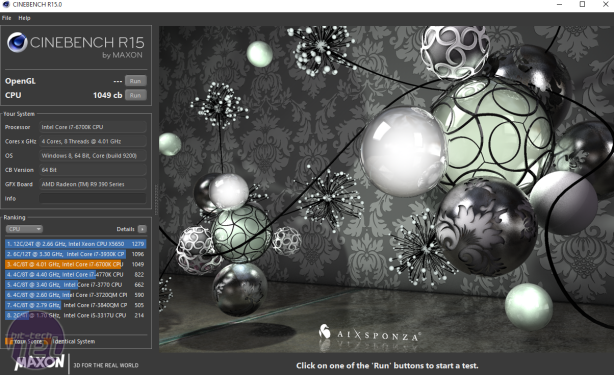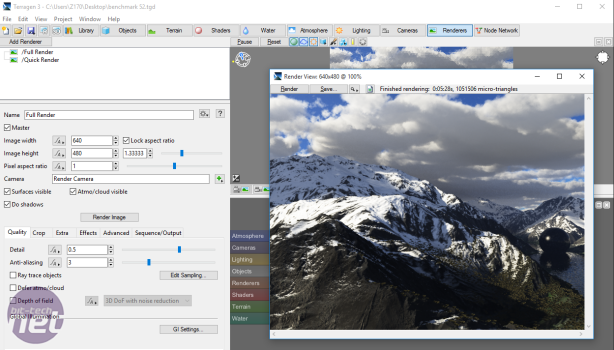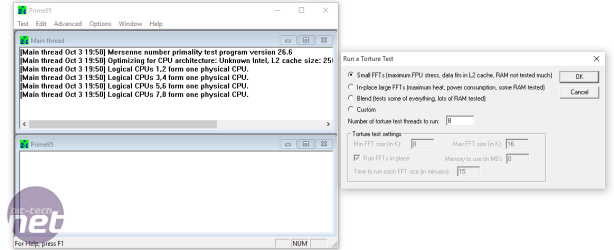
Cinebench R15 64-bit
Website: www.maxon.netCinebench uses Maxon's Cinema 4D engine to render a photo-realistic scene of some shiny balls and weird things (we miss the motorbike). The scene is highly complex, with reflections, ambient occlusion and procedural shaders so it gives a CPU a tough workout.
As Cinema 4D is a real-world application - used on films such as Spider-Man and Star Wars - Cinebench can be viewed as a real-world benchmark.

Cinebench R15
64-bit, CPU test
- MSI Z170A XPOWER Gaming Titanium Edition (4GHz/4.8GHz)
- Asus Maximus VIII Hero (4GHz/4.8GHz)
- Asus Sabertooth Z170 Mark 1 (4GHz/4.8GHz)
- MSI Z170A Gaming M5 (4GHz/4.6GHz)
- Asus Maximus VIII Impact (4GHz/4.9GHz)
- MSI Z170A Gaming Pro Carbon (4GHz/4.8GHz)
- MSI Z170I Gaming Pro AC (4GHz/4.6GHz)
- Asus Maximus VIII Gene (4GHz/4.8GHz)
- Gigabyte Z170X-Gaming 7 (4GHz/4.8GHz)
- MSI Z170A SLI Plus (4GHz/4.7GHz)
- Asus Z170i Pro Gaming (4GHz/4.8GHz)
- Asus Z170-Deluxe (4GHz/4.8GHz)
- Gigabyte Z170MX-Gaming 5
- Gigabyte Z170-Gaming K3 (4GHz/4.8GHz)
-
-
934
-
1038
-
-
-
930
-
1054
-
-
-
929
-
1024
-
-
-
929
-
1009
-
-
-
928
-
1057
-
-
-
927
-
1044
-
-
-
926
-
1008
-
-
-
925
-
1040
-
-
-
924
-
1039
-
-
-
919
-
999
-
-
-
917
-
1052
-
-
-
904
-
1017
-
-
-
883
-
1044
-
-
-
856
-
1014
-
0
250
500
750
1000
Score, higher is better
-
Stock Speed
-
Overclocked
Terragen 3
Website: Terragen 3Planetside Software’s Terragen 3 is a highly realistic landscape generator used to create background images in films and games such as Star Trek: Nemesis, Stealth and The Imaginarium of Dr. Parnassus. Our script renders a single frame of a snowy mountain scene at 640 x 480 on all the available CPU execution units.

Terragen 3
Snowy scene render time
- MSI Z170A XPOWER Gaming Titanium Edition (4GHz/4.8GHz)
- Asus Sabertooth Z170 Mark 1 (4GHz/4.8GHz)
- Asus Z170i Pro Gaming (4GHz/4.8GHz)
- Asus Z170-Deluxe (4GHz/4.8GHz)
- MSI Z170A Gaming Pro Carbon (4GHz/4.8GHz)
- MSI Z170A Gaming M5 (4GHz/4.6GHz)
- MSI Z170I Gaming Pro AC (4GHz/4.6GHz)
- Asus Maximus VIII Hero (4GHz/4.8GHz)
- Asus Maximus VIII Gene (4GHz/4.8GHz)
- Asus Maximus VIII Impact (4GHz/4.9GHz)
- Gigabyte Z170X-Gaming 7 (4GHz/4.8GHz)
- MSI Z170A SLI Plus (4GHz/4.7GHz)
- Gigabyte Z170MX-Gaming 5 (4GHz/4.8GHz)
- Gigabyte Z170-Gaming K3 (4GHz/4.8GHz)
-
-
369
-
330
-
-
-
370
-
329
-
-
-
370
-
329
-
-
-
370
-
332
-
-
-
372
-
331
-
-
-
372
-
342
-
-
-
373
-
342
-
-
-
374
-
326
-
-
-
375
-
334
-
-
-
376
-
324
-
-
-
377
-
330
-
-
-
379
-
341
-
-
-
387
-
331
-
-
-
393
-
339
-
0
100
200
300
400
Seconds, lower is better
-
Stock
-
Overclocked
Power Consumption
Website: Prime95For the power consumption tests, we measure via a power meter at the wall, so the numbers below are of total system power draw from the mains, not the power consumption of a CPU itself. Measuring the power draw of any individual component in a PC is tricky to impossible to acheive. We use Prime95's smallFFT test to put the CPU under 100 percent load, while idle power results were taken with the PC sitting at a Windows Aero-enabled desktop.

Power Consumption (Idle)
Windows Aero enabled
- Gigabyte Z170-Gaming K3 (4GHz/4.8GHz)
- Gigabyte Z170X-Gaming 7 (4GHz/4.8GHz)
- Gigabyte Z170MX-Gaming 5 (4GHz/4.8GHz)
- Asus Z170i Pro Gaming (4GHz/4.8GHz)
- Asus Maximus VIII Impact (4GHz/4.9GHz)
- MSI Z170A Gaming Pro Carbon (4GHz/4.8GHz)
- MSI Z170A SLI Plus (4GHz/4.7GHz)
- Asus Sabertooth Z170 Mark 1 (4GHz/4.8GHz)
- Asus Maximus VIII Gene (4GHz/4.8GHz)
- MSI Z170I Gaming Pro AC (4GHz/4.6GHz)
- MSI Z170A Gaming M5 (4GHz/4.6GHz)
- Asus Maximus VIII Hero (4GHz/4.8GHz)
- Asus Z170-Deluxe (4GHz/4.8GHz)
- MSI Z170A XPOWER Gaming Titanium Edition (4GHz/4.8GHz)
-
-
45
-
70
-
-
-
46
-
73
-
-
-
48
-
70
-
-
-
49
-
60
-
-
-
50
-
58
-
-
-
51
-
64
-
-
-
51
-
86
-
-
-
53
-
56
-
-
-
53
-
70
-
-
-
55
-
66
-
-
-
56
-
73
-
-
-
61
-
66
-
-
-
62
-
77
-
-
-
75
-
95
-
0
25
50
75
100
Watts, lower is better
-
Stock Speed
-
Overclocked
Power Consumption (Load)
Windows Aero enabled
- Asus Maximus VIII Gene (4GHz/4.8GHz)
- Asus Maximus VIII Impact (4GHz/4.9GHz)
- Gigabyte Z170MX-Gaming 5 (4GHz/4.8GHz)
- Gigabyte Z170X-Gaming 7 (4GHz/4.8GHz)
- Asus Sabertooth Z170 Mark 1 (4GHz/4.8GHz)
- Gigabyte Z170-Gaming K3 (4GHz/4.8GHz)
- Asus Maximus VIII Hero (4GHz/4.8GHz)
- MSI Z170I Gaming Pro AC (4GHz/4.6GHz)
- MSI Z170A SLI Plus (4GHz/4.7GHz)
- Asus Z170i Pro Gaming (4GHz/4.8GHz)
- MSI Z170A Gaming Pro Carbon (4GHz/4.8GHz)
- MSI Z170A Gaming M5 (4GHz/4.6GHz)
- MSI Z170A XPOWER Gaming Titanium Edition (4GHz/4.8GHz)
- Asus Z170-Deluxe (4GHz/4.8GHz)
-
-
113
-
172
-
-
-
113
-
198
-
-
-
122
-
197
-
-
-
123
-
173
-
-
-
124
-
180
-
-
-
124
-
197
-
-
-
125
-
183
-
-
-
128
-
140
-
-
-
129
-
167
-
-
-
135
-
166
-
-
-
137
-
187
-
-
-
144
-
186
-
-
-
143
-
194
-
-
-
148
-
197
-
0
50
100
150
200
Watts, lower is better
-
Stock Speed
-
Overclocked









Want to comment? Please log in.